1、程序结构:
千言万语,不如一张图来的清晰
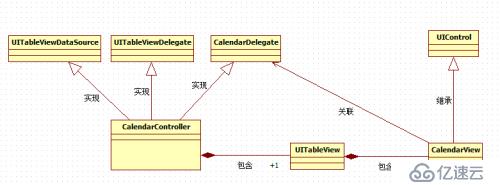
1) 由于CalendarController包含了一个UITableView指针,因此CalendarController需要实现UITableDataSource以及UITableViewDelegate与UITableView进行交互。 2) UITableView包含多个CalendarView,这样就能利用UITableView的手势滑动功能以及Cell重用功能。 3) CalendarView继承自UIControl,因为UIControl将相对底层的触摸事件转换为容易操作的控件事件。主要为了使用UIControlEventTouchUpInside这个事件。 4) CalendarDelegate仿照ios mvc模式,用于类之间的解耦(面向接口编程)以及类之间的通信。
2、 CalendarDelegate 协议:
@protocol CalendarDelegate <NSObject> //年月和UITableView以及其中CalendarView之间关系映射 //具体见下面代码分析 -(int) calcCalendarCount; -(SDate) mapIndexToYearMonth : (int) index; -(int) mapYearMonthToIndex : (SDate) date; //用于显示到指定的年月范围 -(void) showCalendarAtYearMonth : (SDate) date; //用于时间期限管理以及选中判断 -(BOOL) isInSelectedDateRange : (SDate) date; -(void) setSelectedDateRangeStart : (SDate) start end : (SDate) end; -(void) setEndSelectedDate : (SDate) end; //迫使整个UITableView重绘 -(void) repaintCalendarViews; //计数器,用于判断touch次数 -(void) updateHitCounter; -(int) getHitCounter; @end
3、 CalendarController:
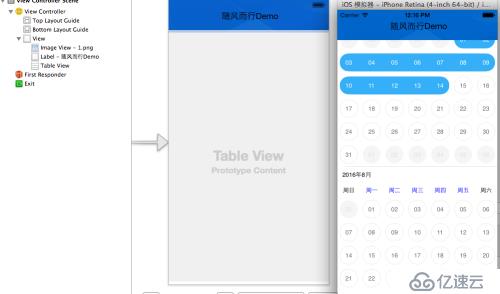
//.h文件接口声明 #import <UIKit/UIKit.h> @interface ViewController :UIViewController @end
//.m文件
#import "ViewController.h"
#import "CalendarDelegate.h"
#import "CalendarView.h"
//实现了如下三个delegate
@interface ViewController () <UITableViewDataSource,UITableViewDelegate,CalendarDelegate>
{
//用于计算出多少个月历,具体见下面代码
int _startYear;
int _endYear;
//每个月历控件的高度,上面的个数和此地的高度,就可以计算整个UITableView的高度以及进行定位操作
float _calendarHeight;
//用于选中操作时候,时间范围的比较(time_t实际是个64位的整型值,适合做比较操作,具体看实现代码)
time_t _startTime;
time_t _endTime;
}
//选中值的年月表示方式,方便显示而已,实际操作都转换成time_t类型
@property (nonatomic,assign) SDate begDate;
@property (nonatomic,assign) SDate endDate;
//点击计数器,用于确定当前点击的奇偶性,因此改月历控件涉及两次操作,用于区域选者
@property (nonatomic) int hitCounter;
//作为Calendar的父容器,用于处理滑动以及cell重用
@property (weak, nonatomic) IBOutlet UITableView *tableView;
@end-(int) calcCalendarCount
{
SDate date;
date_get_now(&date);
//计算出当前的年月到n年前的1月份的月数
//加设当前为2016年8月,n为5,则月份范围为[2011年1月---2016年8月 总计月数为68],具体算法如下:
int diff = _endYear - _startYear + 1;
diff = diff * 12;
diff -= 12 - date.month;
return diff;
}
//UITableView的DatatSource有个必须实现的协议函数,用于返回当前UITableView可以容纳的总数:
- (NSInteger)tableView:(UITableView *)tableView numberOfRowsInSection:(NSInteger)section
{
int ret = [self calcCalendarCount];
return ret;
}- (CGFloat)tableView:(UITableView*)tableView heightForRowAtIndexPath:(NSIndexPath *)indexPath
{
//返回的是当前的calendarView的高度
//UITableView需要知道月历(月份)的个数以及月历控件的高度,就可以计算出整个UITableView的Content的height了
return _calendarHeight;
}千言万语,不如再来一张图来的清晰
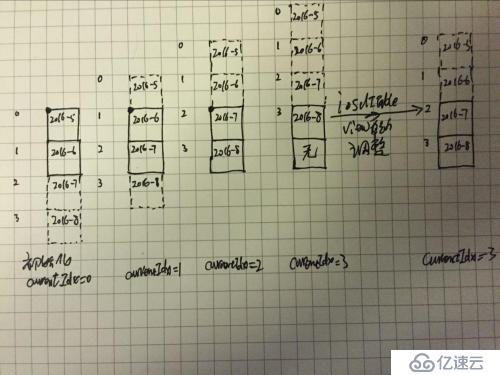
-(SDate) mapIndexToYearMonth : (int) index
{
SDate ret;
//调用c函数,将索引号映射成年月,用于UITableView创建calendarView时现实月历标题
date_map_index_to_year_month(&ret, _startYear, index);
return ret;
}
//调用mapIndexToYearMonth:
- (UITableViewCell *)tableView:(UITableView *)tableView cellForRowAtIndexPath:(NSIndexPath *)indexPath
{
static NSString* calendarID = @"calendarID";
float width = self.tableView.frame.size.width;
//从行索引号映射到年月
SDate date = [self mapIndexToYearMonth:(int)indexPath.row];
//获取重用的cell
UITableViewCell *cell = [tableView dequeueReusableCellWithIdentifier:calendarID ];
//如果为null,说明不存在,创建该cell
if(cell == nil)
{
//可以在此断点,查看一下具体生成了多少个calendarView(我这里生成了3个)
//说明UITableView可见rect有三个calendarView相交
cell = [[UITableViewCell alloc] initWithStyle:UITableViewCellStyleDefault reuseIdentifier:calendarID];
[cell setTag:10];
//手动创建CalendarView
CalendarView* calendarView = [[CalendarView alloc] initWithFrame:CGRectMake(0, 0, width, _calendarHeight)];
//设置CalednarDelegate
calendarView.calendarDelegate = self;
//给定一个tag号,用于重用时获得该view
[calendarView setTag:1000];
[cell.contentView addSubview:calendarView];
}
//通过tag号,获取view
CalendarView* view =(CalendarView*) [cell.contentView viewWithTag:1000];
//设置CalendarView的年月
[view setYearMonth:date.year month:date.month];
//[view setNeedsDisplay];
return cell;
}
-(int) mapYearMonthToIndex:(SDate)date
{
int yearDiff = date.year - _startYear;
int index = yearDiff * 12;
index += date.month;
index -= 1;
return index;
}
//调用mapYearMonthToIndex
-(void) showCalendarAtYearMonth:(SDate)date
{
if(date.year < _startYear || date.year > _endYear)
return;
//将年月表示映射成UITableView中的索引号,根据索引计算出要滚动到的目的地
int idx = [self mapYearMonthToIndex:date];
//如上图所示:当idx = calendarViews.length-1时,可能存在超过整个UITableView ContentSize.height情况,此时,UITableView会自动调整contentOffset的值,使其符合定位到最底端,android listview也是如此。
self.tableView.contentOffset = CGPointMake(0.0F, idx * _calendarHeight );
}1) 从上图以及代码,应该很清楚的了解了映射和定位问题的过程 2) 从上图中,我们也可以了解到UITableView的滚动原理,UITableView的Frame是Clip区域,滚动的内容存放于Content中。 3) UITableView可以说是移动开发中最常用,最重要的一个控件(还有一个是UICollectionView)。有两个主要功能点:滚动(UIScrollView父类)和cell复用。以后有机会我们来从头到尾实现一个带有上述功能的控件。
- (void)viewDidLoad
{
[super viewDidLoad];
// Do any additional setup after loading the view, typically from a nib.
//获取当前的年月
SDate date;
date_get_now(&date);
//default有3年
_startYear = date.year-3;
_endYear = date.year;
/*
//当年也支持
_startYear = date.year;
_endYear = date.year;
*/
//touch 计数器
_hitCounter = 0;
float scale = 0.6F;//硬编码,最好由外部设置
//float scale = 0.5F;//硬编码,最好由外部设置
_calendarHeight = self.tableView.frame.size.height * scale;
self.tableView.dataSource = self;
self.tableView.delegate = self;
//default定位显示当前月份
if (self.begDate.year == 0) {
self.begDate = date;
[self showCalendarAtYearMonth:date];
}else{
//当然你也可以设置具体月份重点显示
[self showCalendarAtYearMonth:self.begDate];
}
}到目前为止,支持CalendarController运行的所有方法都分析完毕,接下来我们要看一下CalendarView相关的实现。(CalendarDelegate还有一些方法没分析,因为这些方法是由CalendarView调用的,由此可见,IOS中的Delegate除了面向接口编程外,还有一个功能就是类之间的通信)
4、 CalendarView:
//.h文件 @interface CalendarView : UIControl -(void) setYearMonth : (int) year month : (int) month; @property (weak, nonatomic) id calendarDelegate; @end
//.m文件
@interface CalendarView()
{
/*
blf:
引用c结构,所有月历相关操作委托给SCalendar的相关函数
SCalendar 使用栈内存分配
*/
SCalendar _calendar;
//这是一个很重要的变量,具体源码中说明
int _lastMonthDayCount;
//存放月历的日期和星期字符串
NSMutableArray* _dayAndWeekStringArray;
//string绘制时的大小
CGSize _dayStringDrawingSize;
CGSize _weekStringDrawingSize;
}- (id)initWithFrame:(CGRect)frame
{
self = [super initWithFrame:frame];
if (self) {
// Initialization code
//年月区块和星期区块的大小按当前view高度的比例来设定
float yearMonthHeight = frame.size.height * 0.095F;
float weekHeight = frame.size.height * 0.089F;
//初始化月历控件,计算出各个区块部分的大小
calendar_init(&_calendar, frame.size, yearMonthHeight, weekHeight);
SDate date = _calendar.date;
//此时date是上个月
date_get_prev_month(&date, 1);
self.backgroundColor = [UIColor clearColor];
//设置日期区块的大小
CGRect rc;
calendar_get_day_cell_rect(&_calendar,&rc,0,0);
CGSize size;
size.height = rc.size.height- 15 ;
size.width = rc.size.width - 15;
//预先分配38个字符串容量的数组
_dayAndWeekStringArray = [NSMutableArray arrayWithCapacity:38];
//0--30表示最多31天日期字符串
for(int i = 0; i < 31; i++)
[_dayAndWeekStringArray addObject: [NSString stringWithFormat:@"%02d",i+1]];
//31--37存储星期字符串
[_dayAndWeekStringArray addObject:@"周日"];
[_dayAndWeekStringArray addObject:@"周一"];
[_dayAndWeekStringArray addObject:@"周二"];
[_dayAndWeekStringArray addObject:@"周三"];
[_dayAndWeekStringArray addObject:@"周四"];
[_dayAndWeekStringArray addObject:@"周五"];
[_dayAndWeekStringArray addObject:@"周六"];
//计算出日期字符串的绘制用尺寸
_dayStringDrawingSize = [self getStringDrawingSize: [_dayAndWeekStringArray objectAtIndex:0]];
//计算出星期字符串的绘制用尺寸
_weekStringDrawingSize = [self getStringDrawingSize: [_dayAndWeekStringArray objectAtIndex:31]];
//UIControl基于控件的事件处理系统,挂接UIControlEventTouchUpInside处理程序
[self addTarget:self action:@selector(handleTouchEvent:forEvent:) forControlEvents:UIControlEventTouchUpInside];
}
return self;
}
//计算要绘制字符串的尺寸的函数如下:
-(CGSize) getStringDrawingSize:(NSString*)str
{
NSAttributedString* attStr = [[NSAttributedString alloc] initWithString:str];
NSRange range = NSMakeRange(0, attStr.length);
NSDictionary* dic = [attStr attributesAtIndex:0 effectiveRange:&range];
CGRect rect = [str boundingRectWithSize:CGSizeMake(0, 0) options:NSStringDrawingUsesLineFragmentOrigin attributes:dic context:nil];
return rect.size;
}从上面类声明和初始化代码,引出几个问题:
1)为什么继承自UIControl? 2)为什么delegate使用weak? 3)为什么delegate 声明为id? 4)为什么栈分配? 5)为什么同一个CalendarView的类声明需要分别在.h和.m文件中,或者换种说法:这样做有什么好处? 6)为什么初始化只实现了initWithFrame,没有实现initWithCoder,在哪种情况下,还需要override initWithCoder函数?
-(void) drawStringInRectWithSize : (NSString*) string rect:(CGRect)rect size:(CGSize) size color : (UIColor*) color
{
CGPoint pos;
//下面算法是让文字位于要绘制的Rect的水平和垂直中心
//也就是剧中对齐
pos.x = (rect.size.width - size.width) * 0.5F;
pos.y = (rect.size.height - size.height) * 0.5F;
pos.x += rect.origin.x;
pos.y += rect.origin.y;
//由于周日和周六与平常文字颜色有差别,因此需要color
NSDictionary * attsDict = [NSDictionary dictionaryWithObjectsAndKeys:
color, NSForegroundColorAttributeName,
nil ];
[string drawAtPoint:pos withAttributes:attsDict];
}1) opengles API 利用gpu加速,速度最快,难度相对最大,自由度也最高,需要创建专用的GL上下文环境。基于状态机模式,需要设置各种绘制状态以及恢复状态。最重要的是跨平台,android以及windows,Linux都可以用(cocos2d-x基于opengles)。 2) quartz API 使用cpu光栅化,不需要GL上下文环境,直接可在控件表面进行绘制,相对底层,基于状态机模式,需要设置各种绘制状态以及恢复状态 3) UIKit中对quartz API的二次封装,例如UIBezierPath类,封装了大部分的shape,方便易用,我们就用这个类来进行绘制。上面两种API,以后有机会我们可以专门来分析一下。
圆的贝塞尔路径对象(由圆心和半径定义):
-(void) drawCircleInRect : (CGRect) rect color : (UIColor*) color isFill : (BOOL) isFill
{
//取width和height最小的值作为要绘制的圆的直径,这样就不会将圆绘制范围超出rect
float radiu = rect.size.width < rect.size.height ? rect.size.width : rect.size.height;
//将圆的中心点从rect的左上角平移到rect的中心点
CGPoint center;
center.x = rect.origin.x + rect.size.width * 0.5F;
center.y = rect.origin. y + rect.size.height * 0.5F;
//圆是由圆心和半径定义的
radiu *= 0.5F;
//创建一个圆的bezier路径对象
UIBezierPath* circle = [UIBezierPath bezierPathWithArcCenter:center radius:radiu startAngle:0.0F endAngle:2.0F*3.1415926F clockwise:true];
//填充绘制(日期选中状态)
if(isFill == YES)
{
[color setFill];
[circle fill];
}
else
{
//没选中状态,用stroke方式绘制
[color setStroke];
[circle stroke];
}
}圆角矩形的贝塞尔对象(由Rect和半径定义):
-(void) drawRoundRect : (CGRect) rect radius : (CGFloat)radius
{
UIBezierPath* roundRect = [UIBezierPath bezierPathWithRoundedRect:rect cornerRadius:radius];
[[UIColor colorWithRed:52/255.0 green:175/255.0 blue:248/255.0 alpha:1.0] setFill];
[roundRect fill];
}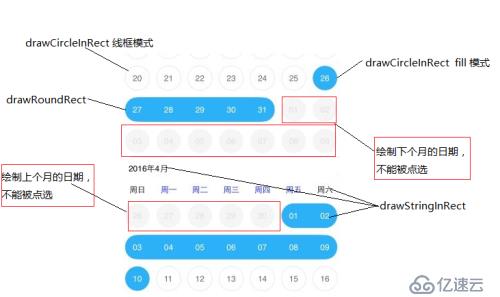
代码很长,我们拆分成几个区块来分析
//1、见上图,绘制年月信息 //blf:获取原生绘图context指针,所有原生绘图api都是c语言api方式 //CGContextRef context = UIGraphicsGetCurrentContext(); CGRect rc; calendar_get_year_month_section_rect(&_calendar, &rc); //NSString* drawStr = @" " + _calendar.date.year + @"年" + _calendar.date.month + @"月"; NSString* drawStr = [NSString stringWithFormat:@"%d年%d月",_calendar.date.year,_calendar.date.month]; //绘制年月信息 [self drawYearMonthStr:drawStr rect:rc];
//2、见上图,绘制星期信息
//_dayAndWeekStringArray中31-37索引保存的是星期字符串
for(int i= 0; i < 7; i++)
{
//获取星期区块中某个cell的rect
calendar_get_week_cell_rect(&_calendar, &rc, i);
if(i == 0 || i == 6)
{
//双休日黑色
[self drawStringInRectWithSize:[_dayAndWeekStringArray objectAtIndex:31 + i] rect:rc size:_weekStringDrawingSize color: [UIColor blackColor]];
}
else
{
//其他时间蓝色
[self drawStringInRectWithSize:[_dayAndWeekStringArray objectAtIndex:31 + i] rect:rc size:_weekStringDrawingSize color: [UIColor blueColor]];
}
}//3、见上图红色边框部分,绘制上个月日期信息
CGPoint dayRectOffset;
//获取日期区块的rect
calendar_get_day_section_rect(&_calendar, &rc);
//纪录日期区块的起始位置
dayRectOffset = rc.origin;
//当前月份1号在日期cells中的起始索引号
int begin = _calendar.dayBeginIdx;
//当前月份结束索引号
int end = begin + _calendar.dayCount;
//绘制上个月的日期,假设begin = 5 i=[4,3,2,1,0]
for(int i = begin - 1; i >= 0; i--)
{
calendar_get_day_cell_rect_by_index(&_calendar, &rc, i);
//计算出位置偏移量
rc.origin.x += dayRectOffset.x;
rc.origin.y += dayRectOffset.y;
//缩小一下绘制rect的尺寸而已
rc.origin.x += 5;
rc.origin.y += 5;
rc.size.width -= 10;
rc.size.height -= 10;
//绘制圆圈
[self drawCircleInRect:rc color:[UIColor colorWithRed:245/255.0 green:245/255.0 blue:245/255.0 alpha:1.0] isFill:YES];
//计算方式涉及到了_lastMonthDayCount
//假设上个月有30天,本月的begin为5,则
//则30-(5-4)= 29 ---->0base--->30号
// 30- (5-3)= 28 ---->0base--->29号
// 30- (5-2)= 27 ---->0base--->28号
// 30- (5-1)= 26 ---->0base--->27号
// 30- (5-0)= 25 ---->0base--->26号
int dayIdx = _lastMonthDayCount - (begin - i);
//绘制圆圈中的日期
[self drawStringInRectWithSize:[_dayAndWeekStringArray objectAtIndex: dayIdx] rect:rc size:_dayStringDrawingSize color:[UIColor colorWithRed:223/255.0 green:223/255.0 blue:223/255.0 alpha:1.0]];
}//4、见上图红色边框部分,绘制下个月日期信息
for(int i = end; i < 42; i++)
{
calendar_get_day_cell_rect_by_index(&_calendar, &rc, i);
rc.origin.x += dayRectOffset.x;
rc.origin.y += dayRectOffset.y;
rc.origin.x += 5;
rc.origin.y += 5;
rc.size.width -= 10;
rc.size.height -= 10;
[self drawCircleInRect:rc color:[UIColor colorWithRed:245/255.0 green:245/255.0 blue:245/255.0 alpha:1.0] isFill:YES];
//索引是i-end,很容易理解的
[self drawStringInRectWithSize:[_dayAndWeekStringArray objectAtIndex: i - end] rect:rc size:_dayStringDrawingSize color:[UIColor colorWithRed:223/255.0 green:223/255.0 blue:223/255.0 alpha:1.0]];
}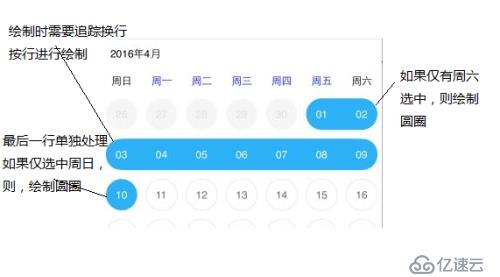
typedef struct _selectRange
{
int rowIdx; //为了方便处理是否同一行
int columIdx;//行列转换一纬数组索引
CGRect rect; //纪录要绘制的rect
} selectRange;//5、绘制当前月份的日期,包括选中,未选中以及日期文字
//使用c结构,并初始化相关变量
selectRange ranges[31];
memset(ranges,0,sizeof(ranges));
int rangeCount = 0;
//绘制当前月的日期
for(int i = begin ; i < end; i++)
{
calendar_get_day_cell_rect_by_index(&_calendar, &rc, i);
rc.origin.x += dayRectOffset.x;
rc.origin.y += dayRectOffset.y;
rc.origin.x += 5;
rc.origin.y += 5;
rc.size.width -= 10;
rc.size.height -= 10;
SDate date;
date_set(&date, _calendar.date.year, _calendar.date.month, i - begin + 1 );
//如果当前日期在选中时间范围内,则batch起来,由drawSelectRange进行绘制
//因为需要处理换行这种效果(drawSelectRange中处理,因此缓存起来二次处理比较方便)
//与delegate通信
if([self.calendarDelegate isInSelectedDateRange:date])
{
ranges[rangeCount].rowIdx = i / 7; //映射成行索引
ranges[rangeCount].columIdx = i % 7; //映射成列索引
ranges[rangeCount].rect = rc; //当前行列的rect纪录下来
rangeCount++; //计数器增加1
}
else
{
//没有选中的,就直接绘制圆圈和当中的日期号
[self drawCircleInRect:rc color:[UIColor colorWithRed:234/255.0 green:234/255.0 blue:234/255.0 alpha:1.0] isFill:NO];
[self drawStringInRectWithSize:[_dayAndWeekStringArray objectAtIndex: i - _calendar.dayBeginIdx] rect:rc size:_dayStringDrawingSize color:[UIColor colorWithRed:107/255.0 green:107/255.0 blue:107/255.0 alpha:1.0]];
}
}
//NSLog(@"select day count = %d",rangeCount);
//rangeCount纪录了选中的数量,ranges则纪录了要绘制的所有信息
[self drawSelectRange:ranges count:rangeCount];
//选中的圈圈的文字由下面代码绘制
for(int i = 0; i < rangeCount; i++)
{
//重新将行列(二维)索引号映射一纬数组索引号
int idx = ranges[i].rowIdx * 7 + ranges[i].columIdx;
//idx - begin就是当前的要绘制的日期文字的索引号
[self drawStringInRectWithSize:[_dayAndWeekStringArray objectAtIndex: idx - begin] rect:ranges[i].rect size:_dayStringDrawingSize color:[UIColor whiteColor]];
}//blf:注意 参数ranges是数组名,数组名表示数组的首地址
// 还有就是selectRange是c结构,当做指针操作时要用->而不是.寻址操作符
-(void) drawSelectRange : (selectRange* ) ranges count : (int) count
{
//两种情况下count = 1
//第一选则,或者第二次选中的和第一次选中的是同一个日期cell
//此时是绘制圆形而不是roundedRect
if(count == 1)
{
[self drawCircleInRect : ranges[0].rect color:[UIColor colorWithRed:52/255.0 green:175/255.0 blue:248/255.0 alpha:1.0] isFill:YES];
//退出函数
return;
}
//并不是第一次选者且第二次选者不是和第一次选者一致时
//获取cell rect的width
CGRect rect;
calendar_get_day_cell_rect_by_index(&_calendar, &rect, 0);
float width = rect.size.width;
//用于纪录上一次的行号,初始化,纪录的是第一行的索引号
int lastRowIdx = ranges[0].rowIdx;
//计数器,用来纪录当前行的cell的数量
int sameRowCellCount = 0;
for(int i = 0; i < count; i++)
{
//从ranges数组中获取一个结构时候,使用了&取地址操作符
//因为防止发生拷贝,如果不是取地址的话,赋值会发生memcopy行为
selectRange* range = &ranges[i];
//行号相同,则同一行啦
if(range->rowIdx == lastRowIdx)
{
sameRowCellCount++;
}
else
{
//行号不同,说明换行了,因此要绘制当前行
CGRect rc;
//i - sameRowCellCount找到起始索引
rc.origin = ranges[i - sameRowCellCount].rect.origin;
rc.size.height = range->rect.size.height;
rc.size.width = width* (sameRowCellCount) - 10.0F;
//很可能存在这种情况,既选中的是周六开始的,因此绘制的是圆形而不是roundedRect
if(sameRowCellCount == 1)
{
[self drawCircleInRect:rc color:[UIColor colorWithRed:52/255.0 green:175/255.0 blue:248/255.0 alpha:1.0] isFill:YES];
}
else
{
//一般情况,绘制roundedRect
[self drawRoundRect:rc radius:rc.size.height];
}
sameRowCellCount = 1;//标记值,为了下面绘制最后一行的代码使用,=1和>1要分别处理
//纪录上一次的行号
lastRowIdx = range->rowIdx;
}
}
//将最后一行拆分出来单独处理,这样就方便处理一些特殊情况
//绘制最后一行
if(sameRowCellCount > 0)
{
CGRect rc;
rc.origin = ranges[count - sameRowCellCount].rect.origin;
rc.size.height = ranges[count - sameRowCellCount].rect.size.height;
rc.size.width = width* (sameRowCellCount) - 10.0F;
//最后一行有多个cell被选中
if(sameRowCellCount != 1)
{
[self drawRoundRect:rc radius:rc.size.height];
}
else//最后一行仅周日被选中,只有一个,圆圈
[self drawCircleInRect:rc color:[UIColor colorWithRed:52/255.0 green:175/255.0 blue:248/255.0 alpha:1.0] isFill:YES];
}
}//由于UITableView采用了cell重用机制,因此仅有很屏幕rect相交的cell存在
//所以是cells一直轮替交换,所以我们必须在每次自绘时候判断当前的cell中的月历的每个日期是否处于选中状态
//而本函数就是起到这样的作用,判断月历中某个日期是否处于选中的区间范围
-(BOOL)isInSelectedDateRange : (SDate) date
{
time_t curr = date_get_time_t(&date);
if(curr < _startTime || curr > _endTime)
return NO;
return YES;
}控件的状态初始化 控件的绘制 控件的事件触发和处理 控件的布局
-(void) handleTouchEvent:(id) sender forEvent:(UIEvent *)event
{
NSSet *touches = [event allTouches];
UITouch *touch = [touches anyObject];
//获取UITouch,将其转换到当前CalendarView的局部坐标系表示
CGPoint upLoc = [touch locationInView:self];
//通过局部坐标系的点获取点击处的cell的索引号,优化部分请看c的相关实现
//这个碰撞检测原理实际在游戏中经常使用,分区缩小范围,然后检测该范围内所有物体的与点(2D)
//或光线(3D)是否发生碰撞,用于此处也非常适合
int hitIdx = calendar_get_hitted_day_cell_index(&_calendar, upLoc);
//选中了,则
if(hitIdx != -1)
{
SDate date;
date_set(&date, _calendar.date.year, _calendar.date.month, hitIdx - _calendar.dayBeginIdx + 1);
//=0为第一次点击,仅选中一个cell
//mod为了周而复始,并在[0,1]之间
if([self.calendarDelegate getHitCounter] % 2 == 0)
{
//第一次点击,让开始和结束Date相同
[self.calendarDelegate setSelectedDateRangeStart:date end:date];
}
else//=1为第二次点击,形成选区
{
[self.calendarDelegate setEndSelectedDate:date];
}
//每次点击,delegate中的点击计数器都要递增的
[self.calendarDelegate updateHitCounter];
//需要触发重绘,让ios进行重新绘制,这个很关键,有一些细节,在下面会说明的
[self.calendarDelegate repaintCalendarViews];
}
}//属于CalendarDelegate的接口函数,实现代码如下:
-(void) repaintCalendarViews
{
//[self.tableView setNeedsDisplay];
for(UIView * subview in self.tableView.subviews)
{
for(UIView* view2 in subview.subviews)
{
UITableViewCell* cell = (UITableViewCell*)view2;
CalendarView* cview =(CalendarView*) [cell.contentView.subviews objectAtIndex:0];
[cview setNeedsDisplay];
}
}
}1) 由于calendarView的选择可能跨越多个CalendarView,因此不能仅仅在CalendarView级别setNeedsDisplay,而是需要让整个UITableView以及他的所有子孙控件都要重绘。 2) 按照正常思路,你在UITableView上调用setNeedsDisplay,你会发现无效。 3) 由此可见,IOS中的脏区局部刷新机制采用的是以控件为基础的后备缓冲图,而不是以整个屏幕为基础的后背缓冲图。 4) 以控件为基础的后备缓冲图内存消耗高,但是能够解决重复绘制,提高效率,典型的以空间换时间策略。 介绍一个微软开源项目WinObjc,非常强大,可以在gitHub中去查找。 为win10和Winphone实现了整个ios sdk,目的是让ios的app直接在winphone上跑。 我研究过他整个局部刷新的机制,还是蛮帅的。 foundation,uikit, glkit,spritekit,gamekit,homekit....各种kit都实现了。而且最重要的是有源码。 5) 以整个屏幕(或者说整个APP显示根节点的size)为大小的后备缓冲区,其只需要增加一张内存位图。 获取脏区后,仅仅递归该脏区以及所有和父节点脏区相交部分的区域 进行更新,因此更新区域会逐渐减小,但是不能完全去除重复绘制。 我曾经实现了opengl和dx版本的2D局部刷新机制,并入到一个2d UI引擎中,利用后背缓冲区以及 基于修改投影矩阵方式,在光栅化之前裁剪掉所有不可见的顶点后, 其渲染速度飞速提高,并且CPU使用率控制在5%以下,大部分时间都是 在1%)。源码不能公布,因为是商业代码,但是demo以后可以在github上下载,很帅的IPhone4仿真模拟。
#define MYSWAP(x,y,type) \
{ \
type t = x; \
x = y; \
y = t; \
}
-(void)setSelectedDateRangeStart:(SDate)start end:(SDate)end
{
//将date转换为time_t
_startTime = date_get_time_t(&start);
_endTime = date_get_time_t(&end);
//如果起始时间大于结束时间,说明先点击后一天,再点击前一天,绘制时的逻辑不正确,需要交换一下时间
if(_startTime > _endTime)
{
MYSWAP(_startTime,_endTime,time_t);
//纪录下年月表示起始结束date
_begDate = end;
_endDate = start;
}else{
_begDate = start;//记录日期
_endDate = end;
}
}
-(void)setEndSelectedDate:(SDate)end
{
//同上,只是针对第二次点击而已
_endTime = date_get_time_t(&end);
if(_startTime > _endTime)
{
MYSWAP(_startTime,_endTime,time_t);
_endDate = _begDate;
_begDate = end;
}else{
_endDate = end;
}
}
-(void) updateHitCounter
{
_hitCounter++;
}
-(int) getHitCounter
{
return _hitCounter;
}至此,IOS版本的源码全部分析完毕,希望对大家有帮助。
关于控件的布局,本DEMO中没什么用到,控件的布局可以说是比较复杂的部分,有各种算法,各种方法,是个比较大的主题,以后有机会探讨。
总体来说,apple公司的objc编译器前端程序Clang支持Objc,c,c++的词法分析,AST的产生,然后进入llvm,生成对应CPU的指令。再在IOS上运行,由于都是二进制,所以效率非常高(苹果公司不允许使用虚拟机代码方式,只能以静态链接库【二进制】方式 运行app,高效, 难以反编译,因此相对非常安全,唯一的例外是运行于浏览器中的js代码)。
免责声明:本站发布的内容(图片、视频和文字)以原创、转载和分享为主,文章观点不代表本网站立场,如果涉及侵权请联系站长邮箱:is@yisu.com进行举报,并提供相关证据,一经查实,将立刻删除涉嫌侵权内容。